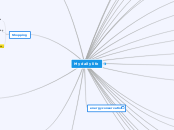My daily life
eating farmed meat
food safety
using of fertilizers in fields
land degradation intensive
soil contamination
using plastic bags
throwing ink and batteries out
using pen/pencil
wasting paper
medical waste
being a beauty product junkie
flushing toilets
buying jeans
washing face
burning of trees
washing clothes
Grocery Shopping
leaving tap opening
energy conservation
listening songs in speakers
leaving the lights on
boiling the kettle
By vehicles
burning of trees
Industries
burning of furniture in home
smoking
House Keeping
Washing of Clothes
Once Chlorine reaches open water and reacts with minerals in the ocean to form dangerous
Keeping House Clean
Muncipal Solid Waste Accumulation
Degraded by Land filling and Inciration
Shopping
Clothes
Jeans, linens, Shirts
A pair of jeans is made up of 2500 gallons of water
Grocery Shopping
Packed in Polymer Covers
Out put waste like chemicals mixed in water
Chemical gases releases in to the air
Cosmetics
Deodrants
Shampos and Face Washes
Over Population
Infrastructure Development
Genetic Engineering
This are used to change the genetic makeup of cell
Introduction to Exotic Species
The species of plants or animals that are growing in a nonnative environment. Alien species have been moved by humans to areas outside of their native ranges.
Waste Disposal
Public Health Issues
Loss of Endarged Species
Household and Industrial Waste
Urban Sprawl
Loss of Tropical
Deforestation
Agriculture clearing and overgrazing
loss of biodiversity
Industrial gaseous
Acid Rains
Nuclear Issues
Increasing Carbon Food Prints
The Phosphorous and Nitrogen Cycle
water pollution
effects on marine life
ocean acidification
soil and land pollution
natural resource depletion
This is consumption of a resource faster than it can be replenished. Natural resources are commonly divided between renewable resources and non-renewable resources.
